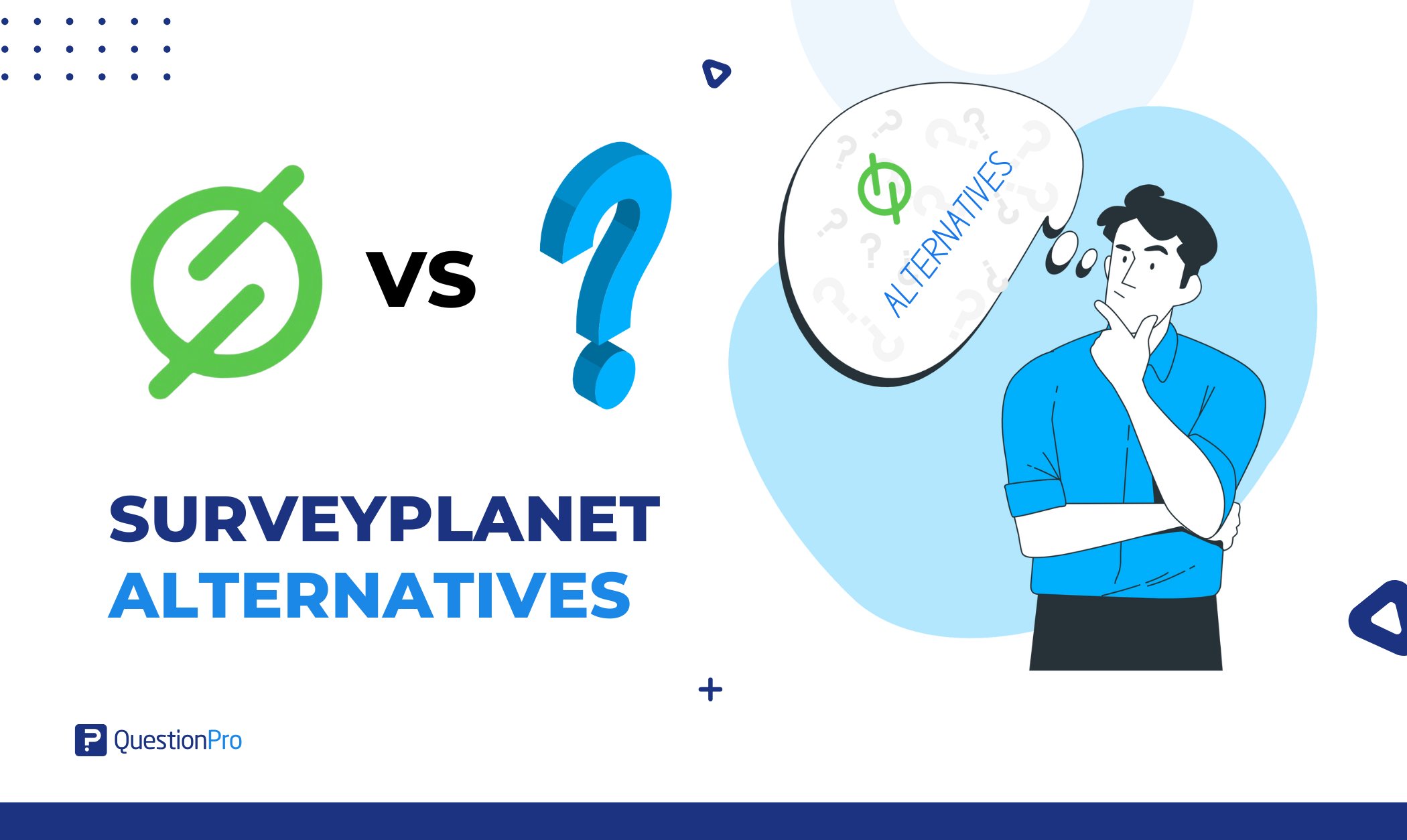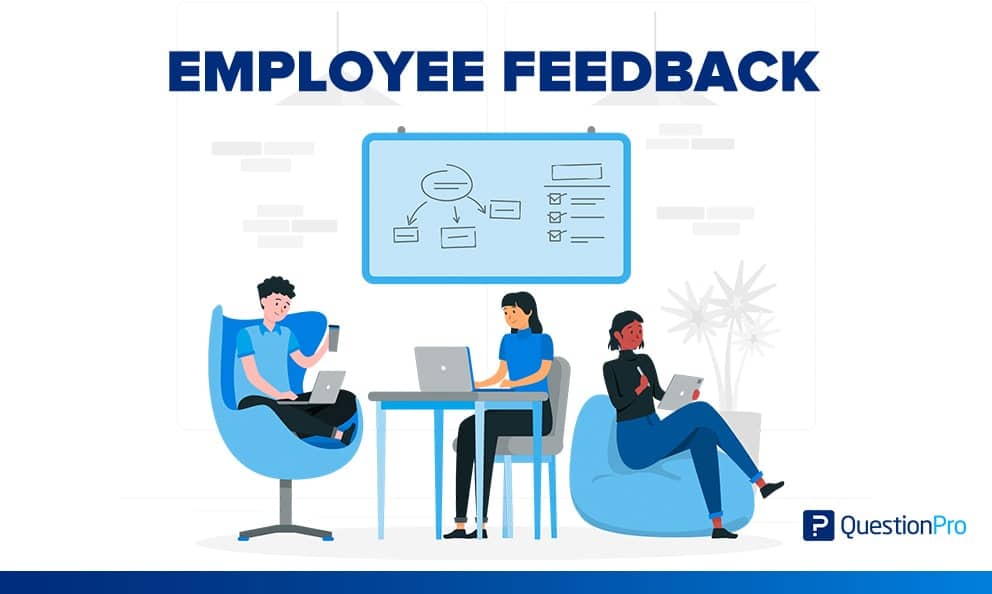
If you’re a company owner, you’re probably not getting the full employee feedback about yourself and your company. The dynamics of employers with their bosses usually come from a specific relationship of respect and cordiality.
For this reason, it’s always a good idea to have some outside insight into their feelings and ideas regarding their experience in the company. This way, you can get ahead and ensure everything is working according to your needs and that the best practices for your company are being met.
Your employees and the company deserve to have an adequate work environment for it to succeed. Today, we bring you everything you need to know to gather useful employee feedback culture.
What is Employee Feedback?
Employee feedback is a process of giving constructive suggestions to employees by their reporting managers, supervisors, and peers. However, this process is not just restricted here. It also comprises the positive and negative feedback that the employee would want to give to his/her manager, peers, or the organization as a whole.
Feedback can help employees and the organization constantly get better at what they do. Employee feedback is an integral part of the employee experience process and a mechanism that will increasingly help employees get better at their job and for the organization develop a better workplace culture.
According to Forbes, 73% of employees consider giving feedback important, but only one-third receive it. Most managers don’t provide enough feedback, and when they do, they tend to make it negative or too vague, and the importance of feedback is lost. As simple as it may sound, giving feedback is not easy. It is a systematically designed process because of the complexities involved- Humans!
Importance of Employee Feedback
Employee feedback is crucial since it informs staff of their strengths and areas for improvement.
This inspires workers to excel at their jobs when it is given care. Additionally, it strengthens ties between employees and management while creating space for an active two-way feedback stream.
There are also extra advantages to think about. To begin with, more productive and engaged employees are closely related to effective employee feedback. Honest employee and employer feedback can help businesses and employees empowerment in many ways:
- It promotes open communication between employees and management.
- Regular feedback can improve employee morale.
- Helpful feedback gives employees clear advice on how to get better.
- Asking for feedback can inspire new ideas and methods.
- Employees feel heard and valued.
In reality, providing positive employee feedback or appropriate feedback at the right time may positively impact employee engagement, performance, job happiness, and your company’s overall financial results.
Nevertheless, you should first comprehend the essential elements of successful feedback to benefit from them. Let’s get started.
Examples of Employee Feedback
Feedback from employees is a very important part of the workplace. It helps employees figure out what they do well and where they could do better. It also helps managers figure out how to improve employee engagement and performance.
There are different ways for employees to give feedback, such as:
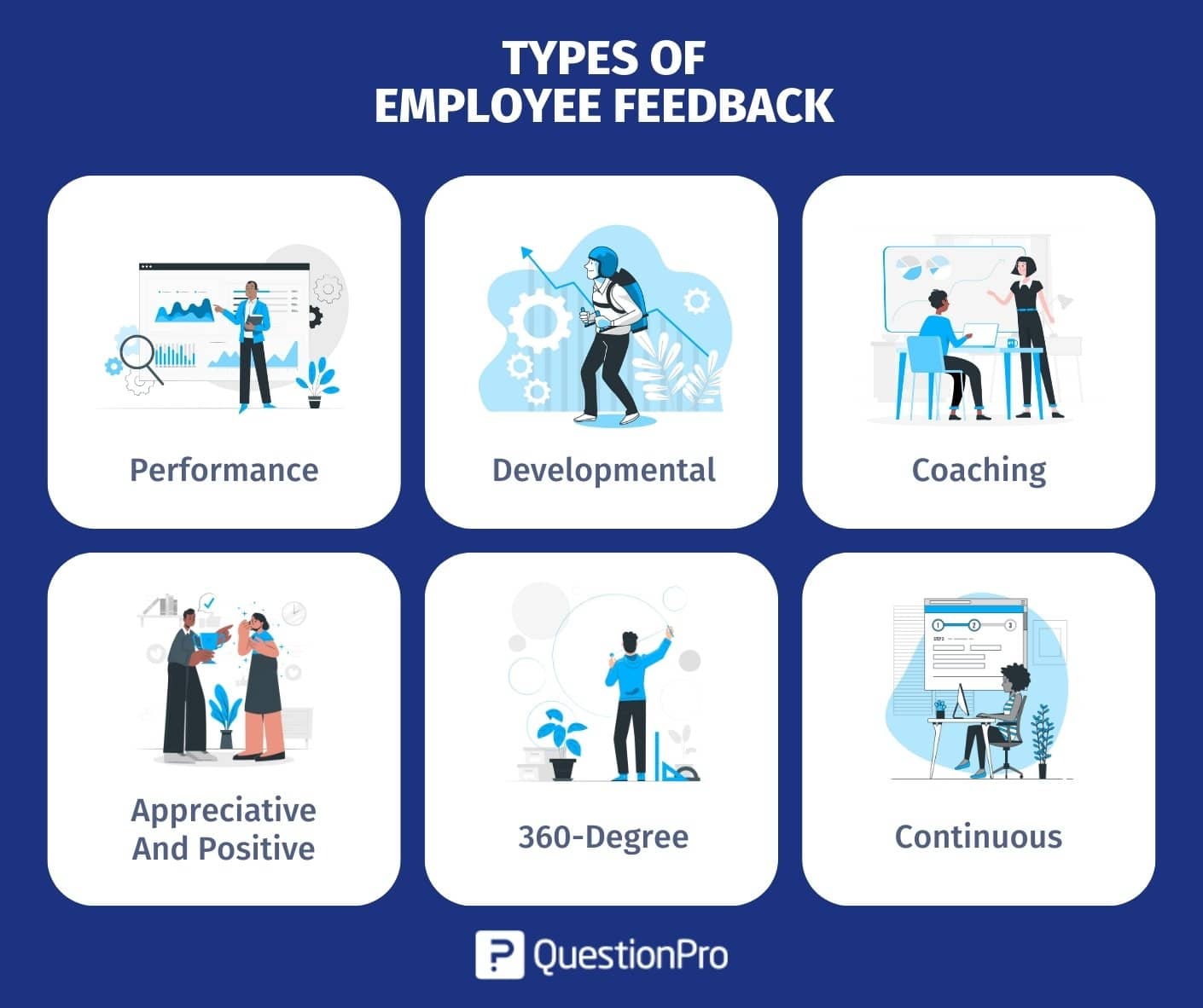
1. Performance feedback
This type of feedback is information given to an employee about how well they are doing their job. Performance feedback helps employees understand their strengths and weaknesses. It may include suggestions for improvement, positive and constructive criticism, or praise for good work. Here are the major components of this type of feedback:
- Strengths: Highlighting what employees are doing well.
- Weaknesses: Addressing areas that need improvement.
- Suggestions for Improvement: Providing actionable steps.
- Goals and Expectations: Aligning the feedback with the organization’s goals and the employee’s individual objectives.
Performance feedback should be an ongoing process rather than a one-time event. Regular feedback, such as quarterly or monthly reviews, can help employees stay on track and feel more supported.
For example, during a feedback session, the performance feedback can be:
Hi Mark, You bring a lot of valuable skills to our team, and I really appreciate what you do. I think if you focus on managing your time better and setting clear goals, you could improve even more. Let’s check in next month to see how you’re doing and if there’s anything else I can do to help.
2. Developmental feedback
Developmental feedback focuses on guiding employees career growth. It helps employees learn new skills or gain new knowledge that will help them advance in their careers. During a quarterly performance review, the manager should focus and talk about these key areas when providing developmental feedback to an employee:
- Skill Identification
- Goal Setting
- Action Plan
- Support
3. Coaching feedback
This type of feedback is meant to help an employee improve certain skills, like leadership or communication. It focuses on the individual’s growth and development.
Let’s say an employee is struggling with communication during team meetings. The manager notices that while the employee has great ideas, he often talks too much and doesn’t leave enough time for others to share. The manager’s feedback could be:
Karl, you always bring great ideas to our meetings, and I appreciate your energy. However, I’ve noticed that sometimes you talk a bit too much, which makes it hard for others to participate. Let’s work together on giving more space for your teammates to share their thoughts so we can create a more collaborative atmosphere.
The manager can start coaching sessions with the employee to offer the support they need. During these sessions, the manager can share ideas and plan activities to help improve active listening skills, such as asking others for their opinions before giving their own.
4. Appreciative and positive employee feedback
This type of feedback is given to employees to show appreciation for their efforts, achievements, and contributions. This is not only boosts morale but also encourages employees to continue their excellent work. Here is an example of appreciative and positive feedback:
Hi Bethany, I just wanted to say how impressed I am with the fantastic job you did on the recent social media campaign. Your innovative ideas for content and smart targeting were evident, and they truly paid off. I noticed that engagement rates doubled, and we saw a 30% increase in sales during the campaign period. Your creativity and attention to detail really made a difference. Thank you for all your hard work! Keep up the fantastic work, and I can’t wait to see what you do next!
5. 360-degree feedback
This type of feedback involves getting feedback from different people, such as colleagues, supervisors, and subordinates, to get a full picture of an employee’s performance evaluation. The feedback may cover various competencies, including:
- Leadership skills
- Communication effectiveness
- Team collaboration
- Problem-solving abilities
- Goal achievement
- Technical skills
Example: During a performance review, an employee might receive feedback from:
- Manager: “You’ve improved your leadership skills significantly.”
- Peer: “Your support during the project launch was essential to our success.”
- Direct Report: “Your guidance on task delegation has been very helpful for my development.”
6. Continuous feedback
The feedback is given all the time, not just at certain times. It lets good work and a positive attitude be noticed quickly, and negative behavior or performance be changed as needed. Here are some moments of continuous employee feedback examples:
- Weekly Check-ins: A manager can have a quick 10-15 minute meeting with an employee each week to talk about what they’re working on, give praise for completed tasks, and suggest ways to improve ongoing projects.
- Project Debriefs: After a finished project, the manager can provide immediate feedback on what went well and what could be improved before the next task starts.
- Real-time Coaching: In a sales setting, a supervisor can observe a salesperson interact with a customer and provide instant feedback.
- Recognition Platforms: Companies can use digital tools to allow employees to provide quick shout-outs for good work. It encourages a culture of continuous recognition and feedback among employees.
Many kinds of feedback can help employees grow and improve in their jobs, which can be good for both the employee and the organization.
7. Peer-to-Peer Feedback
This type of feedback focuses on sharing insights between colleagues to build trust and enhance team cohesion. It often addresses aspects like collaboration, support, or individual contributions.
The advantage of this feedback is that, coming directly from your workforce, it tends to be more objective and honest, offering a unique perspective.
Example:
I really appreciate how you stepped in to help me finish the report when I was overwhelmed. It shows great teamwork.
8. Managerial Feedback
Managerial Feedback refers to comments provided by managers to employees regarding their performance, behavior, or progress.
Given its hierarchical nature, this type of feedback tends to have a significant impact on organizational culture, making it essential for managers to approach it thoughtfully and responsibly.
Example:
Your customer service scores have been consistently high this month. Keep up the great work, and let’s discuss how we can maintain this momentum!
9. Constructive Feedback
This type of feedback is aimed at identifying areas for improvement in a supportive and non-judgmental manner.
It incorporates a human element, is generally well-received, and brings numerous benefits to team morale, both at an individual and group level.
Example:
I noticed you’ve been missing a few deadlines recently. Is there a specific challenge you’re facing? Let’s work together to adjust your workload or find a solution.
10. Real-Time Feedback
Provided immediately after an action or event to reinforce or address behaviors promptly.
Example:
That was an excellent point you brought up in the meeting just now. It clarified the direction for the entire team.
Employee Feedback Survey Questions
It is important for an organization to develop a set of survey questions based on different attributes to formulate an employee feedback survey, so the feedback that the organization receives should be robust and foolproof. These questions need to be systematic simultaneously and easy to understand and respond to.
The survey should have a good balance of open-ended and closed-ended questions for the respondent’s ease. Stuffing the survey with too many open-ended questions leaves a loose end, and the responses cannot be measured based on human resource metrics. The following are the questions an organization must use to receive overall employee feedback from his/her manager or peers.
01. Employee feedback questions for individual reflection
- What are the responsibilities you purview as important?
- How can the organization help you with employee career growth?
- While handling the [project name], did you do anything outside your scope of work?
- Is there a scope for personal growth in this organization?
02. Employee feedback questions for leadership reflection
- How comfortable do you feel giving feedback to your manager? Please rate from 1 to 5.
- How much do you agree with this statement: ‘My manager often talks to me about my career and growth opportunities’?
- Can you give an example of a time when your feedback led to a positive change in the team?
- On a scale of 1 to 10, how much do you think your feedback helps improve the team’s performance?
03. Employee feedback questions for organizational reflection
- As an organization, are we doing well in keeping our strategies well-defined?
- What are the three things we as an organization can do differently?
- On a scale of 0-10, how likely are you to refer the organization to your family/friends for employment?
- Could you please elaborate on your choice of answer? [This question is a follow-up question]
04. Employee feedback questions for employee satisfaction reflection
- Do you have the flexibility to work remotely if required?
- Do you feel your work contributes to your organization’s overall goals?
- Do you feel you are able to maintain a healthy work-life balance?
- Do you feel the review policies are fair in this organization?
What are the Types of Employee Feedback Survey?
There are many types of employee feedback, including 360-degree employee reviews, continuous feedback mechanisms, and employee performance evaluations, to name a few.
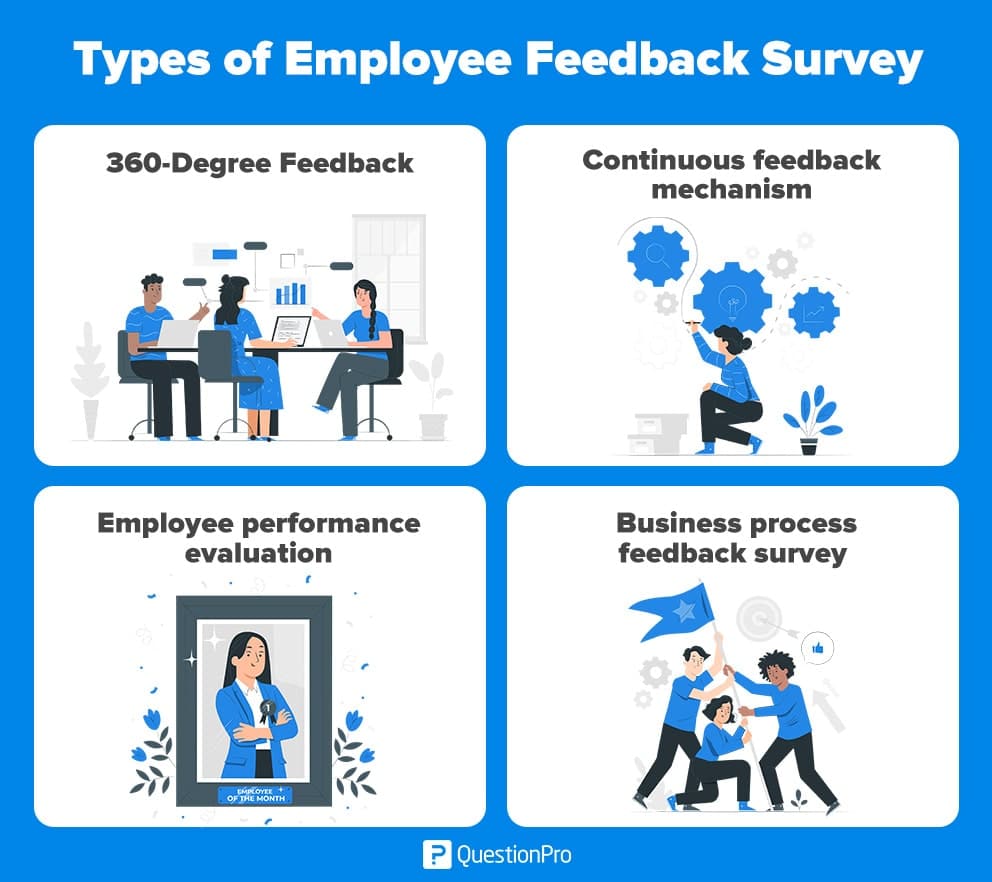
1. 360-degree feedback
360-degree feedback is a process in which an employee receives feedback from his/her superiors, manager, and peers to identify the strengths and weaknesses of an employee so that immediate corrective measures can be taken to improve employee performance.
The purpose of 360-degree feedback is to understand an employee’s performance and collect feedback and reviews. This mechanism of employee feedback allows a multi-pointer rating and serves as a benchmark for an employee’s development plan.
However, in 360-degree feedback, it is essential that feedback remains anonymous. The purpose of this anonymity is to keep it strictly professional so it doesn’t lead to any differences between the employee receiving the critical feedback and the manager or peer giving the feedback.
2. Continuous constructive feedback mechanism
Continuous feedback is a process where an employee receives feedback on a timely basis. Imagine an organization where employees are willing to get feedback, but managers are not willing to spend any time giving the needed feedback. No point in guessing the lowered levels of employee motivation that it would bring.
There are a number of benefits of continuous feedback- it promotes a healthy workplace culture, helps employees and organizations set better goals, and boost employee morale, and this, in turn, leads to happy employees. However, continuous feedback is a complex process and should be done carefully.
The process should not be scary for employees; feedback doesn’t have to be negative. It needs to be constructive. No organization would want to promote a culture where employees don’t trust the leadership and vice versa. This is not a process where you will blame the employees for why they have not achieved their targets. This is a process to help employees improve themselves through constructive employee feedback.
3. Employee performance evaluation
Employee performance evaluation is a formal method of providing feedback on the employee’s performance based on their work and results based on their job responsibilities. It is used to measure the amount of value added by an employee in terms of organization growth, job satisfaction, revenue generated, and overall return on investment (ROI)
Any organization that has learned the art of winning from within understands the importance of feedback. They rely on a systematic performance evaluation process and grade employees annually based on the feedback received from their managers.
Ideally, employees are graded with a promotion or increase in the increment received and similar methods. Performance evaluation also plays a vital role in providing periodic feedback to employees to make them more self-aware regarding their performance metrics.
4. Business process feedback survey
A Business Process Feedback Survey is a type of survey that aims to get feedback from employees about certain business processes in an organization. These surveys aim to find ways to improve and ensure that processes are effective, efficient, and aligned with what employees want and need.
Business Process Feedback Surveys can cover a wide range of topics, such as onboarding, training, performance reviews, employee engagement, benefits, and other internal processes. You can tailor the survey questions to fit the processes being evaluated. They can be open-ended, include a rating scale, or offer multiple-choice options.
The results of a Business Process Feedback Survey can tell an organization a lot about how well its business processes are working. By identifying necessary changes, an organization can implement improvements that increase productivity, boost employee happiness, and enhance the overall workplace environment.
Best Practices for Employee Feedback
Feedback is often a pain point, whether you are giving or receiving one. It comes with an unsaid intention of saying, “you need to change.” And change can be overwhelming. Some people are receptive to it, and some may take a back step, so how exactly will giving feedback help employees or an organization?
The answer is that the way in which you provide the feedback makes all the difference. Here are some of the best practices that you should look out:
01. Trust makes feedback receptive
Trust is not an action. Humans feel it when they are involved. You can’t ask an employee to trust an organization and vice versa without setting up a platform. Trust comes with emotional willingness.
02. Have an agenda
Feedback should not be vague. Feedback should not be vague. Both those giving and receiving feedback should agree on what will be discussed and why. Having a clear agenda helps everyone involved to be prepared and avoid surprises.
03. Build a culture of transparency
If you don’t build a culture of transparency in your organization, employees will be afraid to give feedback. An open-door policy is a good start. If you want to lead by example, this also means you need to be open to help and receive feedback at any time.
04. Ask and not simply tell
Start with a question: “How do you think you are performing on project XYZ?” This provides relevant context and shows the employee that you are genuinely interested in their progress. Feedback is a mechanism to help individuals improve.
05. Stay focused
Employee feedback can end up long if you dig deep into several different topics. Do you have a number of extra company programs that you want to ask about? Try separating those into a separate survey to ask about them, and add a general overall feedback question about the variety of programs your company culture offers instead.
06. Don’t write leading questions
Writing a leading question is easy. Even asking, “How satisfied are you with…” can be leading! Test the neutrality of your questions with other reviewers so that you’re certain you’re not creating leading questions.
07. Do tell your employees the results – even if it isn’t easy
Open communication is still the best, even if the survey results aren’t what you were hoping for. And, let’s face it, if you’re looking at a widespread level of dissatisfaction across the board, or even in one particular area, it’s highly likely your employees are already talking about it a lot and that they are aware it’s an issue.
08. Field more than once a year
Let’s face it; more employees expect to be able to provide feedback more than once a year. This can also help mitigate those times when perhaps factors outside of your control were affecting employee responses.
You might consider doing a weekly satisfaction check-in, an abbreviated version of a quarterly employee feedback survey. That way, you’re giving your employees a venue to provide feedback, and, just as with customer satisfaction surveys, as soon as things seem to be going awry, you can take action to address it.
Advantages of Employee Feedback
The advantages associated with employee feedback include the following:
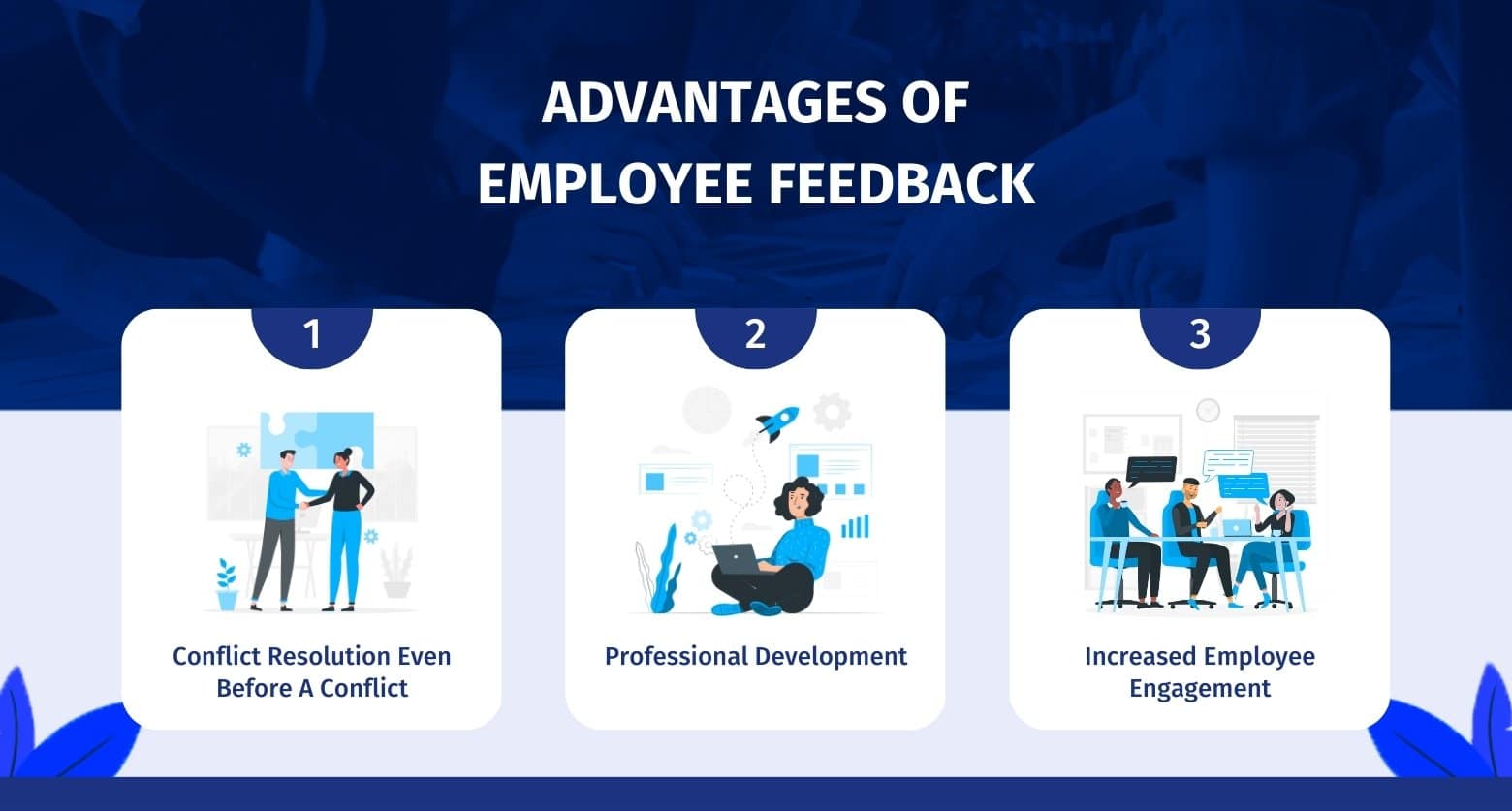
Conflict resolution, even before a conflict
One benefit of an open feedback culture is that it facilitates conflict resolution even before a conflict escalates. Employees in an organization should feel they can openly discuss with their managers or peers and vice versa. Feedback here will be a dialogue and not a monologue.
Employees who regularly give or receive feedback won’t feel any anxiety associated with the process. This means they will know how to handle a tense situation and take the feedback seriously.
Professional development
The more an employee becomes comfortable asking/giving feedback, the more they will take this up as their own initiative. This will lead to more organized professional development.
Increased employee engagement
When an organization has a transparent culture, a well-designed feedback mechanism in place, immediate attention to any potential issues, etc., there will definitely be an increase in the levels of employee engagement. Remember, feedback is not just about employees or an organization improving. It is also about doing good work time and again.
Tips for Creating Effective Employee Feedback Surveys
Employee surveys can be a useful tool for managing employee performance when done right. The survey results can help create new strategies to improve the organization. You can design these surveys to encourage employees to participate more and leave them feeling positive.
- Give your employees enough time to complete the employee feedback survey and keep sending reminders if needed to help them keep pace with the activity. Don’t expect an immediate response from them. If you rush your employees, chances are they won’t respond correctly to the survey.
- Offer perks or rewards to your employees for completing the task or being proactive about responding to the survey. Make it more fun than a mundane one. Your employees should feel confident about registering their feedback and not overwhelmed.
- Ensure that the employee feedback surveys the management receives are anonymous. In order to gain the maximum insight, you would want to tell them that their feedback is 100% confidential.
- These surveys become insignificant if employees feel unheard or if management doesn’t act on them. Once employees provide their feedback, ensure you address the important matters as soon as possible. Small adjustments or big changes can differentiate between happy and unhappy employees.
How QuestionPro Can Help You with Employee Feedback?
Now that you’ve learned everything you need to know about employee feedback and why it’s important for any serious company, it’s time to implement the best practices possible. If you are looking for a platform to start evaluating your work environment, at QuestionPro, we can help you.
You can use QuestionPro’s survey software platform to gather employee feedback and analyze data. QuestionPro can help with employee feedback in the following ways:
- Create customized employee surveys: QuestionPro offers several pre-built templates that you can customize to create an employee survey tailored to your organization’s needs. You can ask questions about employee engagement, job satisfaction, communication, work-life balance, and other topics.
- Collect feedback in real-time: With QuestionPro, you can get feedback from employees in real-time via email, the web, and mobile devices. This lets you know how employees feel right away so you can deal with problems quickly.
- Analyze feedback data: Once you have collected feedback from employees, QuestionPro gives you powerful reporting and analytics tools to help you look at the information. You can make custom and direct reports, see how the data looks, and find trends and patterns to help you make decisions.
- Take action on feedback: QuestionPro also has tools to help you act on feedback from employees. You can create action plans, assign tasks, and track progress to ensure you address feedback and show employees that you take their feedback seriously.
It is a flexible tool that can help companies collect, analyze, and act on employee feedback. By using QuestionPro to find out what your employees think, you can make them more productive and engaged.
Frequently Asked Questions (FAQs)
Employee feedback involves constructive comments and suggestions provided by managers, peers, or colleagues to help employees improve performance.
It helps employees understand their strengths and areas for improvement, fostering personal and professional growth.
Feedback can be constructive, positive, developmental, or evaluative, depending on its purpose and delivery.





